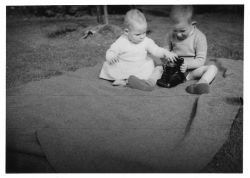My darkroom gets used more for developing films these, I really only print when assembling or expanding exhibition sets. So printing sessions tend to be maybe over 2 to 4 days and maybe 6 or more hours a day.
I had my first camera in 1956/7

It was a few years around 1965 that I developed my first films and made my first prints using my mothers old Brownie 127 at school. I didn't really get serious until 1968, and had my first pictures on newspaper and magazine front page in 1971 made with a Zenit E. I still have my original Gnome 35mm Universumenlarger looks like a motor bike cylinder head with it's cooling fins.
I learnt everything from Kurt Jacobson's two excellent books Enlarging and Printing borrowed from my schools library, the large two part Focal Press Encyclopedia of Photography, and also AP. I was asked to teach youger pupils photography in 1970 during my last year at school. I made my first colour pints around 1970 using Kurt Jacobson's Pavelle paper and chemistry which was sold under the Paterson brand. Later Durst bough Pavelle for their technology and expertise renaming it Durts UK and it made their higher end professional equipment including roll head printers etc.
Later while a student I contributed to the NUS newspaper in Birmingham and after began specialising in portraits and models, portfolios, this wasn't planned it was just the circle of riends at that time and things snowballed by word of mouth. I dallied with Ferrania reversal processing but it was a horrible complex process and then E3, the E4 process was too toxic except for machine use so all kits were E3 which gave identical results.
I moved to MF in 1976 with a Mamiya C33 and a C3 and the following year added an LF camera a De Vere monorail, with whole plate, half plate and 5x4 backs. By this time I'd just set up a photographic company specialising in large scale images on vehicles or advertising signs, so I was working as a photo/emulsion chemist, and also doing research. The Bhopal disaster killed that business because in 1986 I couln't get insurance to use the Iso-Cyanate Acrylic lacqeurs needed to protect the images, despite using air-line respirators and protective clothing.
So I changed direction and began working the jewellery trade initially shooting a new catalogue for friends the ended up in precious metal recovery with a spell manufacturing Gold refineries before joining one of my customers as an empoyee, eventually setting up an analysis lab. This freed me up and realising I wanted to shoot LF landscpes as I'd not benough conrol with MF and bought a Wista 45DX around 1987 which I still use although I'm also using a Graflex Super Graphic often hand held, as well as my 10x8 Agfa Ansco Commercial View, and Half plate ( using7x5 holders) Kodak Specialist 2.
Somewhere in the background from arounsd 1977 onwards I also worked with various rock and reggae bands largely though two friends who were associated with a studio and a record label, that has continued and although one of the friends died in 1987 actually expanded unexpectidly around 2004, but by then everything was digital. For over 3 years I was working with over 30 bands doing location shots and more importanly live shots but 3 nights a week and 3 or 4 bands each night and sometimes two venues on the same night alongside working 9-5 was enough and I walked away.
The last concert I photographed was a dichotomy I was there to photograph the support act who I'd been working with for 2 years, excellent musicians and music, great songs and lyrics, but a lead singer (also the song writer) who was too nasal and alway performed drunk. They had made some great videos but the vocalist let them down. I'd intended to go home I was quite tired but then the main band came on stage, I'd heard the name but not ever deliberately listed to their music, surprisingly it was the first time they'd played in their home town Stourbridge, so I stayed and kept photographing The Wonderstuff. What amazed me was I knew every number and musically they were superb.
Photography is like music in many ways, there are different approches to how we see and tell our visions.
Ian


